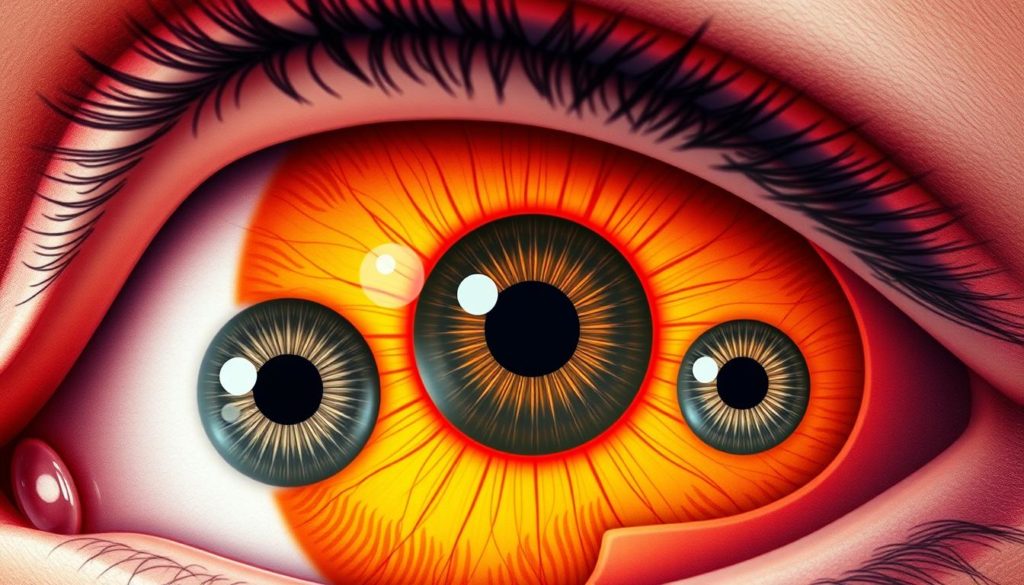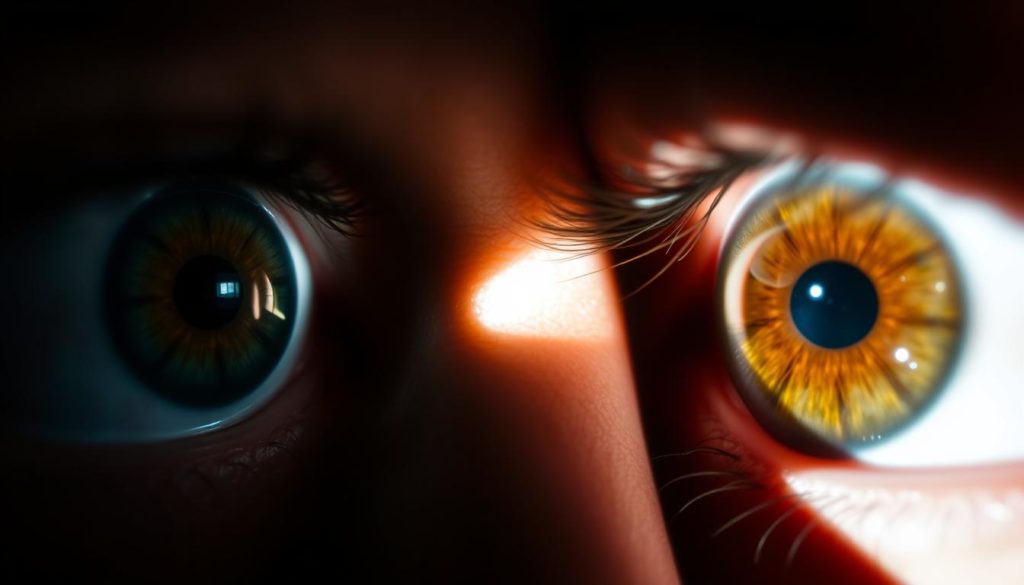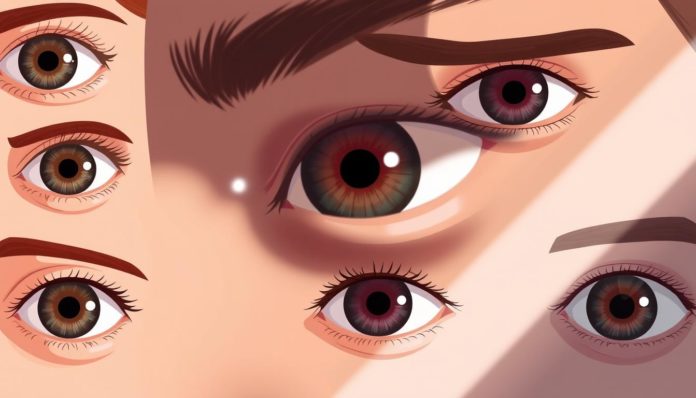“The eyes are the windows to the soul.” — William Shakespeare
Our eyes, especially the pupils, give us a peek into our health and vision. Though small, they are key to how we see the world. Let’s explore the anatomy and function of eye pupils and their role in eye health and diagnosing problems.
Pupils adjust to light and show our emotions. They are crucial for vision. This journey will reveal why knowing about eye pupils is essential for good eye health and vision. Let’s uncover the secrets of these small but vital parts of our eyes.
What Are Eye Pupils?
The eye pupil is a key part of our *visual system*. It’s a small, black circle in the iris that controls light. Knowing about the *pupil anatomy* helps us understand how we see the world.

The Anatomy of Eye Pupils
The pupil is surrounded by the iris, the eye’s colored part. It changes size based on light. The muscles in the iris help it open and close.
This complex *pupil anatomy* makes sure the right amount of light gets to the retina. This is crucial for clear vision.
The Function of Eye Pupils
The *pupil function* is vital for our *visual system*. It controls how much light gets in. In bright light, it gets smaller to protect the eye.
In dim light, it gets bigger to let more light in. This helps us see better in different light conditions. It’s key for good vision and eye health.
How Pupil Size Varies
The size of your pupils changes a lot. It depends on what’s happening inside and outside your body. Knowing this is key for optometry experts to check your eye health.

Factors Affecting Pupil Size
Many things can change pupil size. This includes light, emotions, and some substances. For example:
- Light Exposure: When it’s bright, pupils get smaller. In the dark, they get bigger.
- Emotional State: Feeling excited or stressed makes pupils bigger. It’s part of how our body reacts.
- Substances: Drinking caffeine or taking certain meds can also change pupil size.
Normal Pupil Size Range
In adults, pupil size usually falls between 2 to 4 millimeters. But, in low light or when we’re excited, they can grow up to 8 millimeters.
| Condition | Pupil Size |
|---|---|
| Bright Light | 2-4 mm |
| Dim Light | 4-8 mm |
| Emotional Arousal | Variable (up to 8 mm) |
Understanding these changes is vital for optometry. It helps doctors diagnose and treat eye problems. Watching how pupillary response changes can also tell us about a person’s health.
The Science Behind Pupil Dilation
Learning about pupil dilation helps us understand how our eyes react to different things. Pupils get bigger in response to various factors. This makes it a fascinating part of how our eyes work.
Let’s explore what causes this and how light and darkness play a role.
What Causes Pupil Dilation?
Pupil dilation happens mainly because of changes in light. It can also be affected by emotions and physical states. The autonomic nervous system, especially the sympathetic part, is key. It makes the iris muscles contract, leading to bigger pupils.
Feeling excited or scared can also make your pupils get bigger. Some medicines and health issues can change how big your pupils are too.
The Role of Light and Darkness
The iris, a muscle ring around the pupil, controls its size. In dim light, the pupil gets bigger to let in more light. This helps us see better.
In bright light, the pupil gets smaller to block too much light. This protects the retina from damage.
In short, controlling pupil size is vital for good vision. It lets our eyes adjust to light and dark, keeping our vision clear and safe.
Pupillary Response and Reflexes
The pupillary reflex is key to how our eyes adjust to light. During an Eye Exam, optometrists check how pupils react to light. This helps them assess eye health.
There are two main types of pupillary reflexes: the light reflex and the accommodation reflex. The light reflex is when the pupil gets smaller in bright light. The accommodation reflex is about adjusting the eye for near or far objects. These reflexes tell us a lot about the brain and nervous system.
To check pupil response, eye exams follow these steps:
- Exposing eyes to different lights to see if they constrict and dilate as they should.
- Using a penlight to shine into the pupil and watch the reaction.
- Testing the accommodation reflex by changing focus from far to near.
Checking pupillary reflexes is important for spotting neurological issues. It helps in understanding how the pupil reacts to light and focus changes. This is key for keeping our eyes healthy.
Understanding Eye Pupils in Relation to Eye Health
Our eyes can tell us a lot about our health. Experts look closely at the pupils during eye exams. Any unusual changes in the pupils can point to health problems.
Pupil Abnormalities
Pupil Abnormalities mean the pupils look or act different. For example, if the pupils are not the same size, it could be a sign of a health issue. Not reacting to light can also be a warning sign, possibly of damage to the optic nerve or brain.
How Optometrists Evaluate Pupils
Optometrists use several tests to check the pupils. They look at how big the pupils are in different lights and if they are even. They also check how well the pupils adjust to changes in focus.
Here’s a detailed look at the methods used in an Optometrist Evaluation:
| Method | Purpose | Details |
|---|---|---|
| Pupil Light Reflex Test | Check Pupil Reaction | Shining a light into each eye separately and observing the response. |
| Anisocoria Test | Measure Pupil Size | Comparing the pupil sizes under consistent lighting conditions. |
| Accommodation Test | Assess Focus Change | Observing pupil reaction to switching focus from near to distant objects. |
Regular eye exams are key to keeping your eyes healthy. They can also catch early signs of diseases. This shows how important it is to understand what an eye exam can reveal.
Medical Conditions Affecting Pupils
Many medical conditions can change how eye pupils work. It’s important to know about these conditions and their link to brain health. This part will look at common disorders and their effects on the brain.
Common Disorders
Doctors in ophthalmology often see these pupil disorders:
- Horner’s Syndrome: It happens when nerves are damaged, causing small pupils and droopy eyelids on one side.
- Adie’s Tonic Pupil: This affects one eye, making it big and slow to react to light but better for close-up tasks.
- Argyll Robertson Pupil: Small, odd pupils that don’t react well to light but work okay for close tasks, often from neurosyphilis.
- Third Nerve Palsy: Damage to the nerve controlling eye movements, causing a big pupil and trouble moving the eye.
The Link Between Neurological Health and Pupil Size
Pupil size and how they react can show if there’s a problem with neurological health. Damage to the brain often shows up in how pupils react:
| Condition | Neurological Implication | Symptoms |
|---|---|---|
| Horner’s Syndrome | Disruption in sympathetic nerve pathway | Pupil constriction, ptosis |
| Adie’s Tonic Pupil | Ciliary ganglion damage | Abnormally dilated pupil, sluggish response to light |
| Argyll Robertson Pupil | Central nervous system syphilis | Small, irregular pupils, poor light response |
| Third Nerve Palsy | Oculomotor nerve damage | Pupil dilation, diplopia |
It’s key for ophthalmology experts to watch and act fast on these conditions. Spotting early signs of neurological health problems through pupil checks can help doctors act quickly.
The Importance of Regular Eye Check-ups
Regular eye check-ups are key for keeping your vision sharp. These exams let eye doctors check your eyes and spot problems early. Catching issues early can stop bigger problems later, making eye care a must for good vision.
An eye check-up has many parts, like checking your pupils. A good look at how your pupils react to light can tell a lot. For example, if your pupils are not the same size or don’t react well to light, it might mean you need to see a doctor.
- Detection of common eye conditions such as glaucoma, cataracts, and macular degeneration.
- Monitoring changes in vision that could affect daily activities.
- Early identification of systemic conditions like diabetes and hypertension through pupil examination.
By going for regular eye check-ups, you help keep your vision and health in top shape. Your eyes can show a lot about your health. So, seeing an eye doctor often is a smart move for your eyes and overall health.
How Pupil Size Can Indicate Health Issues
Pupil size and shape are not just interesting facts about our bodies. They are also important for spotting health problems. Knowing the signs in pupils can help us catch issues early. So, it’s key to understand these signs.
Warning Signs in Pupils
Changes in pupil size can show health issues. For example, if one pupil is bigger than the other, it might mean something’s wrong. If you see big or lasting changes, see an eye doctor right away.
- Unequal Pupil Sizes
- Non-Reactive Pupils
- Unusual Pupil Shapes
When to Consult an Ophthalmologist
If you see any unusual signs in your pupils, get to an eye doctor fast. They can check your eyes and find out what’s going on. Catching problems early helps keep your eyes healthy.
Understanding Pupil Constriction
Pupil Constriction, or miosis, is when the pupils get smaller. This is key for controlling light in the eye. It helps us see clearly.
Many things can make the pupils get smaller. For example, bright light makes them close up to protect the retina. Some medicines, like opioids, can also make the pupils smaller.
The parasympathetic nervous system controls this. When light hits the eye, the brain sends a signal. This makes the pupils get smaller to protect the eye.
| Factor | Reaction | Result |
|---|---|---|
| Bright Light | Pupil Constriction | Reduced Light Entry |
| Use of Opioids | Constricted Pupils | Controlled Light Entry |
| Parasympathetic Activation | Pupil Constriction | Improved Vision Acuity |
Pupil constriction does more than just manage light. It also helps with depth and focus. Smaller pupils make images sharper by reducing light scatter.
Doctors, especially optometrists, need to know about pupil constriction. It helps them check for eye problems. Regular eye checks are important for eye health.
The Role of Pupils in Vision
Understanding how pupils work is key to knowing how we see the world. Pupils control how much light gets into our eyes. This is crucial for clear vision. We’ll look at how pupils help us focus and how their size affects vision.
How Pupils Affect Focus
Pupils change size to let in the right amount of light. In bright light, they get smaller to protect our eyes and help us focus. In dim light, they get bigger to let in more light, helping us see better.
The Correlation Between Pupil Size and Clarity of Vision
The size of our pupils affects how clear our vision is. Big pupils in low light can cause some blur. But small pupils in bright light help us see sharper. Knowing this helps doctors and helps us keep our eyes healthy.
Advancements in Optometry and Ophthalmology
The fields of optometry and ophthalmology are seeing big changes. New technologies and research are making eye care better. They help doctors diagnose and treat eye problems more accurately.
Technological Innovations
New Optometry Innovations bring advanced tools for eye exams. These tools give detailed views of the retina and check peripheral vision. They also help find the right lens prescription for patients.
Ophthalmology Advances are also moving fast. Artificial intelligence is being used to analyze eye exam data. This helps doctors spot diseases like glaucoma and macular degeneration quickly. Laser surgeries for cataracts are also becoming more common, leading to better results and faster healing.
Future Directions in Pupil Research
Pupil Research is key in eye health studies. It shows how pupil size can tell us about brain health and thinking. New imaging and pupillography are helping to understand these links better.
Smart contact lenses with sensors are another exciting area. They can track pupil size and eye health in real-time. This could lead to better eye care and more research in the field.
| Optometry Innovations | Ophthalmology Advances |
|---|---|
| Advanced Retinal Imaging | AI-Powered Diagnostics |
| Automated Refractors | Laser-Assisted Cataract Surgeries |
| Visual Field Analyzers | Neuroimaging Technologies |
| Smart Contact Lenses | Pupillography Studies |
The Psychological Aspects of Pupil Responses
Looking into how our pupils react can reveal a lot about us. Our pupils don’t just react to light. They are closely linked to our feelings and how we think. When we feel strong emotions like fear, love, or excitement, our pupils get bigger.
Our thinking also affects our pupils. For example, when we face tough mental tasks, our pupils get bigger. This is studied a lot in psychology to learn more about how we think and process information.
By studying these patterns, researchers can learn a lot about our minds and feelings. This way of studying is non-invasive and gives us a peek into how we handle information and react emotionally. It’s a key part of psychological research.
- Emotional State: Strong emotions often make our pupils bigger.
- Cognitive Functions: When we’re using our brains hard, our pupils get bigger too.
By understanding how our pupils, feelings, and thinking are connected, scientists can find new ways to check on our mental health.
| Factor | Response |
|---|---|
| Emotional State | Pupil Dilation from emotions like fear, love, or excitement |
| Cognitive Functions | Pupil Enlargement during complex mental tasks |
Daily Habits for Maintaining Healthy Eyes and Pupils
Keeping your eyes and pupils healthy is easy with simple daily habits. Eating a balanced diet is key. Include foods rich in vitamins A, C, and E, and minerals like zinc. Leafy greens, fish with omega-3, and nuts are great for your vision and pupil care.
Good lighting is also crucial for your eyes. Make sure you have enough light when reading or working. This helps avoid eye strain. Also, follow the 20-20-20 rule to prevent eye fatigue from screens.
Wearing protective eyewear is another important habit. It’s vital for sports, household chores, or jobs with eye hazards. Safety glasses protect your eyes from injury. Sunglasses with UV protection also help keep your pupils safe from harmful rays.
By making these habits part of your daily life, you’re taking care of your eyes and pupils. Simple choices can greatly improve your eye health. This way, you can enjoy clear vision for many years.
FAQ
What are eye pupils and why are they important?
Eye pupils are the black circles in the center of the iris. They let light into the eye. This is key for clear vision and eye health.
What is the anatomy of eye pupils?
The pupil isn’t a solid part but an opening controlled by the iris. The iris has muscles that change the pupil’s size. This helps manage light and vision.
How does pupil size vary?
Pupil size changes with light, emotions, and some medicines. In bright light, adults’ pupils are 2 to 4 millimeters. In the dark, they are 4 to 8 millimeters. This change is important for eye health checks.
What causes pupil dilation?
Pupil dilation happens in low light, when we’re excited, or with some medicines. It lets more light in, helping us see better in the dark.
What is the pupillary reflex and why is it important?
The pupillary reflex changes pupil size with light or focusing. It protects the retina and helps us see clearly. Doctors check this reflex to see if our eyes and brain are working right.
How can pupil abnormalities indicate eye health issues?
Problems like uneven pupil sizes or slow responses can show eye or brain issues. Doctors use special tests to find these problems and keep an eye on our health.
What medical conditions can affect pupils?
Issues like Horner’s syndrome, brain injuries, or infections can change pupil size or function. These problems often link to brain health and how pupils react. So, doctors check pupils to diagnose these issues.
Why are regular eye check-ups important?
Regular eye exams are key for good vision. They catch problems early and help treat them quickly. During these exams, doctors check pupil health as part of a full vision check.
What are the warning signs in pupils that might indicate health issues?
Signs like always big or small pupils, uneven sizes, or slow responses are warning signs. If you see these, see an eye doctor for a detailed check.
What is pupil constriction and its significance?
Pupil constriction, or miosis, makes the pupil smaller. It’s a natural response to bright light, protecting the retina. It also helps us see more clearly and in depth.
How do pupils affect vision focus and clarity?
Pupils adjust to control light, affecting how we focus on objects. Proper pupil function ensures clear vision by balancing light and supporting focus.
What are some advancements in optometry and ophthalmology?
New tech in eye care has brought better tools, treatments, and research. These advancements help doctors diagnose and treat eye problems more effectively.
How do psychological factors influence pupil responses?
Emotions and thinking can change how pupils react. For example, excitement or focus can make pupils bigger. This is studied to understand the mind-body connection.
What daily habits can maintain healthy eyes and pupils?
Healthy eyes and pupils come from good habits. Eat right, manage screen time, use good lighting, and wear protective eyewear. Exercise and not smoking also help.


